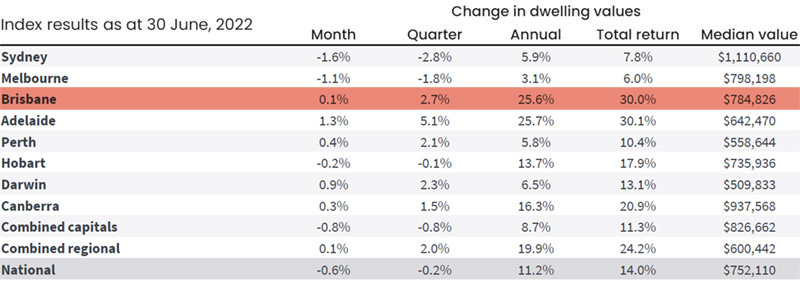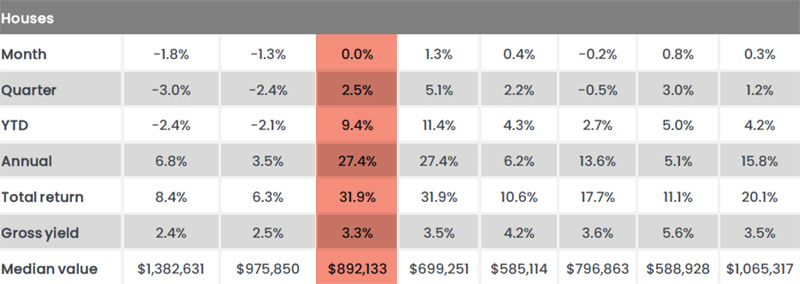Brisbane's reign as king of property price growth is over
Brisbane's property market has outshone the rest of the country for a year but its reign as the capital growth king is over, with monthly market increases limited to just 0.1 per cent.
The king of property growth in Australia has lost its crown.
Brisbane’s exalted position as the fastest growing market in the country is over, with monthly growth slowing to a trickle and Adelaide, Darwin, Perth and Canberra outperforming the Queensland capital last month.
The Brisbane property market is starting to transition, following changes that have been observed in other markets around Australia over recent months.
The new record high median value for Brisbane dwellings is $784,826, which is $4,934 more than at the end of May.
Brisbane recorded its lowest preliminary clearance rate since mid-November 2020 (36.4 per cent) at 43.6 per cent, according to CoreLogic data released Monday (11 July).
Market performance is becoming difficult to gauge, with sales within the same suburb experiencing very high demand, selling very quickly and achieving strong prices, while at the same time other properties either sit on the market without much buyer interest, or we are seeing properties pass in at auction with little bidding activity.
It is very specific to each property and the demand that each individual home generates.
There has also been a shift in demand in some locations away from housing stock towards the unit and townhouse market, driven by affordability constraints.
This is evidenced by a higher volume of people turning up to open homes, which generally translates to more offers due to greater competition from buyers, resulting in a faster sale. This is not surprising given the much stronger 12-month growth in the housing market in Brisbane, up 27.4 per cent, compared to the unit market which grew 15.8 per cent over the same period.
Unit market strong
Units and townhouses are providing a more affordable option for buyers who are happy to compromise on the property type to stay in their preferred locations. The median value for a house in Greater Brisbane is now $892,133, whereas the median value for a unit is just $501,074.
Throughout June, median values in the housing market in Brisbane remain unchanged, according to CoreLogic Data, whereas the unit market increased 0.8 per cent. Houses make up a much larger portion of the total dwellings in Brisbane, compared to units.


Source: CoreLogic.
A large contributing factor to the changing circumstances throughout Brisbane is the negative sentiment that exists throughout the wider market.
Off the back of the sharp increase in inflation has come a sharp increase in mortgage rates.
While the RBA’s interest rate hikes have been a necessary step to return rates to more normal levels, the hysteria around the reporting of these moves has created a lot of concern for many buyers.
Media hype can have a significant influence on consumer sentiment and many buyers feel uncertain about the future, given the reports that have been released in relation to predicted property price falls.
The reality is that a change in consumer sentiment might be all that is required to fuel the Brisbane property market once again. This is due to the fact that Brisbane has very strong underlying housing market fundamentals.
Supply levels, as measured by listing volumes, are still down 18 per cent in Brisbane, compared with 12 months ago, according to CoreLogic, and listings are still trending well below the five-year average across the city.
This trend is specific to Brisbane, because when we look at Sydney and Melbourne, listings in those two cities are now trending above the five-year pattern.
Brisbane still a national magnet
The lower volume of properties available for sale, combined with a lower volume of building completions, is limiting the number of available choices for property buyers and therefore suppressing the amount of available supply throughout the city.
While there is suppressed demand due to rising interest rates and the subsequent impact on consumer sentiment, there is still a sufficient level of demand throughout Brisbane to cater for the properties that are coming up for sale.
Jobs growth has been outstanding in the last 12 months leading to record low unemployment and wage increases are imminent.
The rate of interstate migration into Queensland has also picked up significantly, with most settling in the southeast of the state. With international borders reopened, housing needs are greater than ever.
More people need more homes, and while not everyone buys when they move to a new area, there is also a lack of rental properties.
The city-wide rental vacancy rate in Brisbane is now 0.6 per cent. There is a city-wide rental crisis. Given the lack of rental supply, coupled with the increased rental demand, price surges have been evident across the city.
In good news for investors but bad news for renters, house rents have increased 13.2 per cent in Brisbane over the last 12 months, leading the rental price growth for houses throughout Australia.
In contrast, unit rents have increased 8.8 per cent over the same period, behind the unit rent growth in Melbourne, Sydney and Adelaide. In some areas increases in excess of 20 per cent have occurred in some Brisbane suburbs.
Due to the rapid increase in rents, we are now seeing gross rental yields improve in Brisbane. Across all dwellings, gross rental yields are now 3.6 per cent, up 0.1 per cent from last month. This is also providing an inflation hedge for investors as they shy away from the volatility that comes with the financial markets.
It is very unlikely Brisbane will witness a lot of distressed selling, especially given record high employment participation rates and relative affordability.
This will help property owners meet debt repayment obligations, despite rising interest rates and high inflation.
There has been a substantial increase in repayment buffers as borrowers have built up their savings safety net during the pandemic.
Additionally, anyone who has purchased a home recently will have been assessed under a mortgage rate scenario 2.5 basis points above the original rate they were offered, and this has actually increased to an assessment rate that is now 3 per cent higher, since October 2021.
Despite the broader market weakness, there will always be areas and properties that perform well, and others that may not.
There will continue to be high demand for some properties and little or no demand for others. When we move into a transitioning market, like the market throughout Brisbane now, understanding the fundamentals becomes critical, as the rising tide will no longer lift all ships.
There are markets within markets and local drivers of supply and demand will become even more important in identifying locations that will continue to perform compared to others.
While there are many commentators suggesting property values in Brisbane will fall, quality properties that are in high demand, despite broader market conditions, will maintain their value now and continue to grow in value into the future.




















